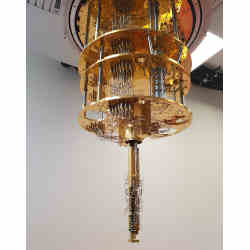
Quantum Inspire, hosted by QuTech, a collaboration of Delft University of Technology and TNO, the Netherlands Organization for Applied research, consists of two independent quantum processors, Spin-2 and Starmon-5, and a quantum simulator. Anyone can create an account, use the Web interface to write a quantum algorithm, and have it executed by one of the processors in milliseconds (if there is no queue), with the result returned within a minute. The process is fully automated.
Seen from the outside, Spin-2 and Starmon-5 are two large, cylindrical cryostats hanging from the ceiling in a university building. One floor up, a man-size stack of electronics for each takes care of the cooling, feeding the quantum processor input from users and reading out the results. Usually, there is no one in these rooms.
The facility officially went online on April 20, and over 1,000 accounts have been created since then. Though many curious visitors never returned, active users now upload about 6,000 jobs a month to be executed.
A quantum computer uses qubits for its computations. A qubit can be a single electron, or an electronic circuit, that has two quantum energy states, which correspond to the 0 and 1 of a classical bit of information. However, the magic of quantum physics enables a qubit to be in a superposition 0 and 1 at the same time, and N qubits that are prepared in a superposition can represent all 2N combinations of these 0s and 1s simultaneously. In a sense, its capacity doubles with every qubit added, so a quantum computer with just 50 error-free qubits could achieve an enormous speed-up compared to a standard computer.
With only two qubits, Spin-2 is mainly a proof of principle, for it is the first time that qubits based on electron spins are accessible online. These consist of a single electron each, trapped in a 'quantum dot', a nanoscale structure on a silicon chip cooled to 0.02 Kelvin (degrees above absolute zero). An electron can be in a superposition of two spin states, 'up' and 'down'. Calibration of the relatively unstable quantum dots still needs manual tuning: every four hours, the system has 20 minutes of downtime.
According to Richard Versluis, principal systems engineer at QuTech and Spin-2 lead, operating spin qubits is currently more difficult than other types of qubits, but they promise advantages in the long run: "They can be built with standard chip technology, and they are so tiny that millions would fit on one chip. The promise is very big, the challenge is also very big."
Starmon-5 has five transmon qubits. A transmon is a superconducting electronic circuit that can be switched between two tunable energy states. With five stable, entangled qubits, Starmon-5 can execute short quantum algorithms composed from a universal set of quantum gates, equivalent to the operations of classical computer logic, like AND and NOT.
Quantum Inspire does not yet offer sufficient qubits to achieve 'quantum supremacy', which means quickly performing a calculation that would take a classical computer thousands of years. Google claimed to have accomplished this last October with it 53-qubit Sycamore machine, although IBM disputed that claim. IBM itself offers Quantum Experience, an online quantum computer with 16 transmon qubits accessible for free.
Said Leonardo di Carlo, QuTech co-founder and Starmon-5 lead, "For us, the educational aspect is important. We plan to include this in our teaching to our students in the fall."
Starmon-5 is a useful testbed for quantum computations, for the correct execution of quantum software is less straightforward than running a few lines of code on a regular computer. Said Di Carlo, "I am an avid user of Quantum Inspire myself. I'm especially interested in learning how our quantum computers can improve from the end-user perspective."
Even a 5-qubit quantum computer that performs reliably is a huge step forward, says Di Carlo. "For example, Starmon-5 executes Grover's search algorithm with 88% success probability. The first time someone did this, in 2012, the success rate was 59%, and that was considered a breakthrough." Grover's algorithm, which does searches similar to looking up a name in a phone directory, is one of the few quantum algorithms that is proven to outperform all classical search algorithms, so it is often used as a test.
Also, Starmon-5 was designed with modularity in mind: a chip with many more transmon qubits would fit into the same cryostat. Di Carlo is cautious about making predictions when such a larger system will become available, but increasing the number of qubits is a key priority.
While QuTech is developing quantum computing hardware, another Dutch collaboration, QuSoft, works on the quantum software that will run on these computers. Koen Groenland, until recently doing a postdoc on 'Few qubit applications' at QuSoft, says Quantum Inspire is an interesting proof of concept, but still too small for serious research applications. According to Groenland, the minimum size for applications will be somewhere between 50 and 200 qubits.
Nevertheless, even with five qubits, valuable experience can be gained. Other than classical bits, which can only be switched from 0 to 1 or vice versa, operations on qubits resemble continuous rotations. Said Groenland, "Lots of variations are possible even with only a few qubits, and this allows you to fine-tune your quantum algorithm till it does what you want."
In quantum computing, size gets most of the attention, but quality matters as well, Groenland said. "On the one hand, you want more qubits, but you also want qubits that stay in superposition long enough to execute an algorithm with many consecutive operations."
Arnout Jaspers is a freelance science writer based in Leiden, the Netherlands.



Join the Discussion (0)
Become a Member or Sign In to Post a Comment